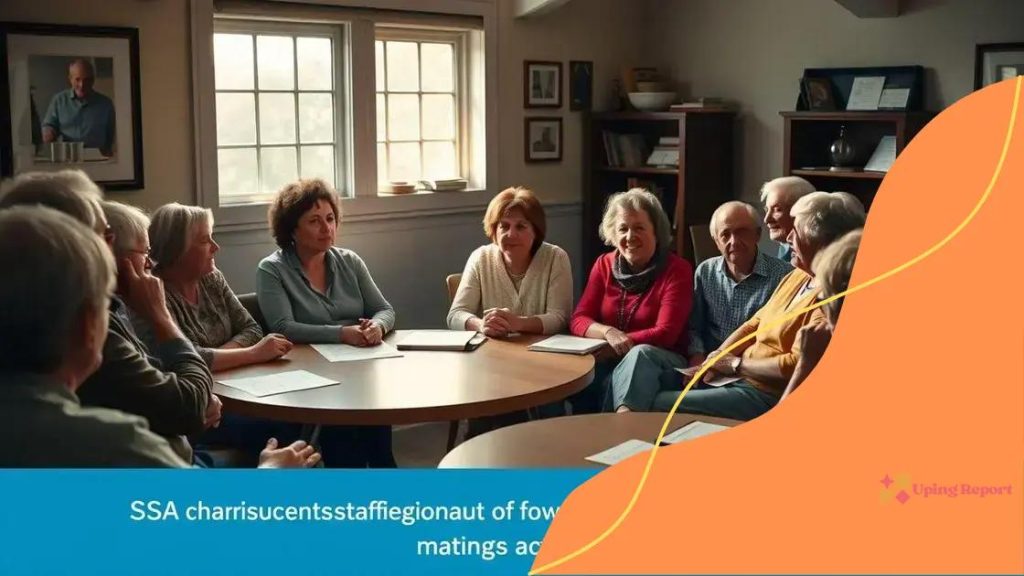SSA staffing cuts raise concerns in the community

SSA staffing cuts raise concerns as they lead to increased wait times, reduced service quality, and significant impacts on vulnerable populations who rely on social security services for support.
SSA staffing cuts raise concerns about the ability to provide essential services to vulnerable populations. These changes could ripple through communities, making you wonder how this might impact your access to necessary support.
Understanding the implications of SSA staffing cuts
Understanding the implications of SSA staffing cuts is crucial for both the service providers and the community. These cuts can significantly affect how social security services are delivered, leading to changes that may not be immediately visible.
Immediate impacts on service delivery
One of the first things noticed will be the increased wait times for services. With fewer staff members available, processing claims and handling inquiries will become more challenging. This can leave many individuals feeling frustrated and anxious as they await assistance.
Potential long-term effects
The long-term effects of SSA staffing cuts could lead to a reduction in service quality. Organizations that rely on SSA support might struggle to meet the needs of their clients effectively. The worst-case scenario is that vulnerable populations could be left without essential services.
- Longer processing times for claims.
- Higher likelihood of errors in claims processing.
- Increased barriers to service access for vulnerable populations.
Moreover, these staffing changes can also strain the morale of remaining employees, who may find themselves overwhelmed and overworked. This could lead to burnout, further exacerbating the problem. The community’s trust in SSA services could also diminish as people encounter delays and inconsistent service.
Impact on community awareness and engagement
As these cuts take effect, communities need to stay informed and engaged. Knowledge about how services are changing will empower individuals to advocate for themselves. They may need to explore alternative resources or support systems if they find SSA services lacking.
Furthermore, the cuts could spark community advocacy efforts. People might come together to voice their concerns, mobilizing to push for better funding and staffing for the SSA. Community leaders can play a significant role in rallying support and drawing attention to the issues caused by staffing cuts.
Who is affected by the SSA cuts?
Understanding who is affected by the SSA cuts is vital to grasp the broader implications of these changes. Various groups within the community will likely experience significant impacts due to reduced staffing and resources.
Vulnerable populations at risk
Social security services play a crucial role in supporting vulnerable populations, including the elderly, disabled individuals, and low-income families. As staffing cuts occur, these groups face challenges in accessing necessary benefits. Delays in applications and reduced support can lead to increased hardship.
The elderly and disabled
Elderly individuals often rely on social security benefits for their daily needs. The SSA cuts may slow down their access to essential services, creating barriers to financial stability. Similarly, people with disabilities may struggle to receive timely assistance, which could affect their ability to live independently.
- Increased wait times for benefits.
- Limited outreach and education about available services.
- Higher stress and anxiety levels among affected individuals.
Low-income families also rely heavily on SSA programs. These cuts could mean that families are not receiving financial help when they need it most. Without timely support, many households may face an uncertain future.
Community service organizations
In addition to individuals, community organizations that assist with social security applications can be significantly impacted. With fewer resources and staff to help navigate the system, these organizations may struggle to meet clients’ needs. This can create a cycle of confusion and delays as clients attempt to access important services.
Understanding the far-reaching effects of SSA staffing cuts helps highlight the importance of maintaining adequate funding and resources. Advocacy for fair staffing levels is essential to ensure that these vital services remain accessible to everyone.
Challenges in service quality post-cuts

After the SSA staffing cuts, the challenges in service quality become more evident. Many individuals seeking assistance will notice a decline in how services are rendered, impacting their overall experience and access.
Increased wait times
One of the most immediate challenges is the increased wait times for services. With fewer staff members available to process claims and respond to inquiries, individuals may find themselves waiting much longer than before. This can be especially frustrating for those who are in urgent need of support.
Errors in processing
As the demand for services rises, the likelihood of errors in processing claims can increase. Staff may feel pressured to work faster, which can lead to mistakes that affect the benefits individuals receive. These errors can create additional stress for applicants who are already facing challenges.
- Common processing issues include lost paperwork.
- Incorrect application of benefits.
- Delays in receiving notifications.
The overall quality of service may decline as employees become overworked and stressed. This can lead to a lack of attention to detail, making it hard for applicants to feel confident that their needs are being met. Additionally, social security representatives might have less time to spend with each individual due to the increased workload.
Communication breakdowns
Communication is another area that suffers. With fewer employees, the ability to effectively communicate with clients diminishes. Calls may go unanswered, emails may be delayed, and individuals may find it challenging to get the information they need. This disconnect can lead to frustration and confusion for those trying to navigate the complexities of social security services.
Addressing these challenges is crucial for restoring public trust in SSA services. Understanding the implications of staffing cuts on service quality can motivate communities to advocate for necessary changes. By highlighting these issues, it’s possible to push for reforms that improve service efficiency and support.
Community responses and advocacy efforts
Community responses to the SSA staffing cuts have emerged as crucial in addressing the challenges faced by individuals relying on social security services. Many residents have begun advocating for change, understanding the importance of maintaining adequate support systems.
Grassroots organizing
Grassroots movements are gaining momentum as community members band together to voice their concerns. This organizing often includes local meetings, rallies, and outreach campaigns designed to inform others about the impacts of the staffing cuts. By coming together, individuals can amplify their voices and make their needs heard.
Building awareness
Increasing awareness is another essential aspect of community response. Many advocacy groups are working to educate the public on how the cuts affect access to services. Information sessions and social media campaigns help spread the word about the struggles faced by vulnerable populations. This outreach can encourage more individuals to get involved in local advocacy efforts.
- Sharing personal stories to highlight the impact.
- Collaborating with local organizations for support.
- Mobilizing volunteers to assist those in need.
Furthermore, community members are reaching out to local representatives to demand action. Petitions and letters to elected officials become powerful tools for expressing discontent and pushing for change. By actively engaging with lawmakers, individuals can highlight the urgent need for sufficient staffing and resources at the SSA.
Collaboration with service organizations
Community responses often include collaboration with local service organizations. These partnerships can strengthen advocacy efforts and provide additional resources for those affected. Organizations that assist with applications can share their experiences, helping to illustrate the challenges faced by applicants. Together, these groups can create a unified front to demand better funding and staffing for SSA services.
As communities continue to mobilize around these issues, there is hope for positive change. Understanding how to advocate effectively not only benefits those directly affected but also builds a stronger and more informed community overall.
Future outlook for SSA services
The future outlook for SSA services is uncertain but crucial for millions of Americans who depend on social security. With recent staffing cuts, the direction of these services will significantly impact individuals and communities.
Potential service improvements
Advocates hope that increased awareness of the challenges posed by staffing cuts will lead to improvements in service delivery. By effectively raising their voices, communities can influence policymakers to prioritize funding for SSA. This could pave the way for **better trained staff** and enhanced technology to streamline services.
Technological advancements
As technology continues to evolve, there is potential for the SSA to utilize new tools that can improve service efficiency. Implementing a more robust online application process and using AI to assist with claim processing may help reduce backlog and wait times. Adopting these technologies may lead to faster access to essential services for individuals who need them.
- Online platforms could facilitate easier claims submissions.
- AI tools might identify and flag errors more quickly.
- Chatbots could provide immediate assistance to inquiries.
However, if cuts to staffing remain, the effectiveness of these technological solutions could be limited. A well-rounded approach must include adequate personnel to handle the increased demand and utilize new systems effectively rather than relying solely on technology.
Advocacy and collaboration
The future will also require continued advocacy from community groups and individuals. Building coalitions that focus on securing funding and raising awareness about SSA challenges will be essential. This collaboration among different stakeholders—government agencies, community organizations, and residents—can strengthen the push for sustainable change.
In summary, the outlook for SSA services depends not only on community involvement but also on effective policy decisions that prioritize the needs of those who rely on social security. By addressing the current challenges and focusing on future improvements, it is possible to create a more responsive and efficient SSA system.
FAQ – Common Questions About SSA Staffing Cuts
What are the main impacts of SSA staffing cuts?
The main impacts include increased wait times, reduced service quality, and a strain on resources for vulnerable populations.
How can communities respond to these staffing cuts?
Communities can respond by organizing advocacy efforts, raising awareness, and contacting local representatives to demand better funding.
What role does technology play in improving SSA services?
Technology can streamline applications and processing, potentially reducing wait times and errors, but it requires adequate staffing to be effective.
Why is advocacy important for the future of SSA services?
Advocacy is crucial to push for necessary funding and resources, ensuring that individuals who rely on SSA services continue to receive timely support.
